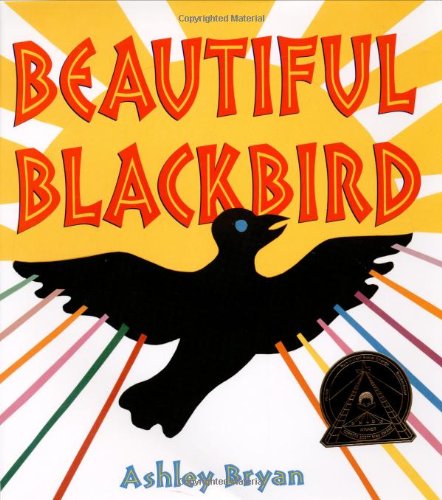
BIBLIOGRAPHY
Bryan, Ashley. 2003.
BEAUTIFUL BLACKBIRD. New York, NY: Atheneum. ISBN 0689847319
PLOT SUMMARY
All of the birds in Africa
hold a meeting to determine which bird is the most beautiful. Without hesitation, all of the birds
determine that it is Blackbird.
Blackbird then agrees to give some of his black color to all of the
other birds. He mixes blackening brew in
his gourd and gives every bird some black, but he tells them all the while that
“I’ll be me and you’ll be you.” The story ends with all the birds singing that
“black is beautiful.”
CRITICAL ANALYSIS
This is one of the most eye-opening and glorious books I have ever read in my life. The theme of this selection, to be yourself, is one of the most important lessons I teach my students. And in complete honesty, I am a white lady teaching mostly non-white students. I needed this book. I needed something that I can share with my diverse students that shows value and beauty in a different culture than what I know. This story has crossed me over into a journey of discovery and realization that I must do more for my students.
In this myth, BEAUTIFUL
BLACKBIRD, Bryan masterfully carries out the oral tradition of the Ila-speaking
people of Zambia. He is true to the root culture of his tale with the dance,
the shaman, and the diction choices he makes. His story has a rhythmic, musical
quality that begs to be read out loud. When you read, “uh-huh, Blackbird, too,”
you can’t help but speak the words aloud.
He also uses onomatopoeia, alliteration, and rhyme to convey the oral
tradition of his tale with such phrases as “flip-flop-flapping” and “whirring,
stirring.”
The illustrations
in this book are actually cut outs of colored paper created by the author. They are simple, colorful alive, and full of
movement and shape. They complement the words of the story and show the energy
and vibrancy of the action.
This myth
does explain where the birds got their black coloring from, but more
importantly, the main theme that “black is beautiful” is impossible to miss.
Bryan also has themes of individuality, “color on the outside is not what’s on
the inside” and the importance of culture, “my black roots,” as well. Bryan writes, “It is important to affirm our
ancestry, to learn about our people while learning about others” (Vardell 95).
In this story, he accomplishes this very thing.
AWARDS AND REVIEWS
*Coretta Scott King Award
Winner
*2x2 Book List
*Publishers Weekly: “Bryan’s lilting and magical language is
infectious.”
*School Library Journal: “This unusual and little-known pourquoi
tale… serves as a thoughtful and entertaining addition to units on
self-esteem.”
*Booklist: “In
this simple adaptation… the message is clear: “Black is Beautiful… Ready-made
for participative storytelling.”
CONNECTIONS
*Students can find Africa
on a map or a globe.
*Students can dance the
Show Claw Slide like the birds in the story do (http://www.kalimba.co.za/)
*For a writing assignment,
have each child pretend to be a bird and write about what color they would be
and why.
*An art project where
students cut out and use colorful shapes to make a scene.
*This story would be
wonderful to have a professional storyteller come read.
*A reader’s theater with
all the students participating; or a dramatization where each student gets a
simple prop for their “bird” character.
*Students can each write a
retelling of a tale from their own unique (religious, ethnic, racial)
background.

Images taken from: https://www.google.com/search?q=beautiful+blackbird&safe=strict&source=lnms&tbm=isch&sa=X&ved=0ahUKEwiOlL7MiqrWAhVm6IMKHVPuCKgQ_AUICygC&biw=1254&bih=527#imgrc=SK1PnIVCVMTXtM:


No comments:
Post a Comment